Temporal–Spatial Patterns of the Water Deficit in the Main Maize-Cropping Regions of China
Abstract
1. Introduction
2. Materials and Methods
2.1. Study Area
2.2. Meteorological Data
2.3. Crop Data
2.4. Meteorological Factors
- (1)
- Reference crop evapotranspiration (ETo).
- (2)
- Crop-water requirement (ETc).
- (3)
- Effective precipitation (Pe).
- (4)
- Trends in the growing season (k).
- (5)
- Water deficit rate (K)
3. Result
3.1. Temporal and Spatial Characteristics of Effective Precipitation
3.2. Temporal and Spatial Characteristics of Water Requirement
3.3. Water Deficit
4. Discussion
5. Conclusions
Author Contributions
Funding
Data Availability Statement
Conflicts of Interest
References
- Michelozzi, P.; De’Donato, F. IPCC Sixth Assessment Report: Stopping climate change to save our planet. Epidemiol. Prev. 2021, 45, 227–229. [Google Scholar] [PubMed]
- Schaubroeck, T. IPCC: Expand into a panel on sustainability. Nature 2023, 616, 661. [Google Scholar] [CrossRef] [PubMed]
- Tong, P.Y. Achievements and prospects of corn production in China. Seed World 1989, 2, 5–7. [Google Scholar]
- Liu, B.; Chen, X.; Meng, Q.; Yang, H.; van Wart, J. Estimating maize yield potential and yield gap with agro-climatic zones in China—Distinguish irrigated and rainfed conditions. Agric. For. Meteorol. 2017, 239, 108–117. [Google Scholar] [CrossRef]
- Dong, C.Y.; Liu, Z.J.; Yang, X.G. Effects of different grade drought on grain yield of spring maize in Northern China. Trans. Chin. Soc. Agric. Eng. 2015, 31, 157–164. [Google Scholar]
- Meng, Q.; Chen, X.; Lobell, D.B.; Cui, Z.; Zhang, Y.; Yang, H.; Zhang, F. Growing sensitivity of maize to water scarcity under climate change. Sci. Rep. 2016, 6, 19605. [Google Scholar] [CrossRef]
- Department of International Cooperation. Ministry of Water Resources. American National Irrigation Engineering Manual; China Water Resources and Hydropower Press: Beijing, China, 1998; pp. 172–173. [Google Scholar]
- Hou, Y.Y.; Zhang, Y.H.; Wang, L.Y.; Lü, H.Q.; Song, Y.B. Climatic suitability model for spring maize in northeast China. Chin. J. Appl. Ecol. 2013, 24, 3207–3212. [Google Scholar]
- Gong, L.J.; Wang, C.; Wang, P.; Lv, S.; Wang, J.; Dai, S. Variation of climate suitability of maize in northeast of China. J. Maize Sci. 2013, 21, 140–146. [Google Scholar]
- Zhao, J.; Yang, X. Average Amount and Stability of Available Agro-Climate Resources in the Main Maize Cropping Regions in China during 1981–2010. J. Meteorol. Res. 2018, 32, 146–156. [Google Scholar] [CrossRef]
- Qu, H.H.; Yang, X.G.; Zhang, X.Y.; Huang, W.H.; Li, M.S.; Li, J.Y. Optimized cropping systems to prevent and avoid the drought disaster based on the adaptation between precipitation and crop water requirement in Hunan Province. Acta Ecol. Sin. 2010, 30, 4257–4265. [Google Scholar]
- Wang, M.T.; Qu, H.H.; Yang, X.G.; Zhang, X.Y.; Li, M.S. Optimized cropping systems based on ensure index of precipitation in Sichuan Province. J. Northwest A F Univ. (Nat. Sci. Ed.) 2012, 40, 82–92. [Google Scholar]
- Zuo, Y.B.; Tang, J.W.; Tian, C.Y.; Lv, S.Y.; Wei, B.; Yang, X.Q.; Gao, Q. Suitability of Water Requirement and Precipitation in Whole Growth Period for Main Crops and Adjustment of Crop Planting Structure in Dezhou. J. Water Resour. Archit. Eng. 2008, 6, 33–34, 42. [Google Scholar]
- Yan, P.; Ji, S.T.; Sun, Y.K.; Jiang, L.X.; Wang, Q.J.; Lv, J.J.; Wang, P. Change characteristics of farmland soil moisture in Fuyu County and their effects on development period and yield of Maize. J. Meteorol. Environ. 2020, 36, 74–82. [Google Scholar]
- Wei, Z.B.; Bian, D.H.; Du, X.; Raj, P.; Cui, Y.H. Characteristics of spatial-temporal distribution ofprecipitation, water requirement and drought forsummer maize growth period in Heilonggang Basin. Trans. Chin. Soc. Agric. Eng. 2020, 36, 124–133. [Google Scholar]
- Cui, R.X.; Fu, J.D. Spatial and Temporal Variation of Coupling between Rainfall and Crop Water Requirements of Cotton in Shandong. Cotton Sci. 2014, 26, 49–57. [Google Scholar]
- Zhang, Q.P.; Yang, X.G.; Xue, C.Y.; Yan, W.X.; Yang, J.; Zhang, T.Y.; Wang, H.Q.; Bauman, B.A.M. Analysis of coupling degree between crop water requirement of aerobic rice and rainfall in Beijing areas. Trans. Chin. Soc. Agric. Eng. 2007, 23, 51–56. [Google Scholar]
- Wang, W.J.; Feng, H. Water requirement and irrigation systems of winter wheat: CROPWAT-DSSAT model solution in Guanzhong District. Chin. J. Eco-Agric. 2012, 20, 795–802. [Google Scholar] [CrossRef]
- Zhang, H.; Wang, H.; Xu, C.G. Spatial and temporal characteristics of water requirement and water deficit of maize in Gansu Province from 1967 to 2017. Acta Ecol. Sin. 2020, 40, 1718–1730. [Google Scholar]
- Yao, D.L.; Gao, F.; Li, Z.J.; Hu, T.T. Water supply and requirement of winter wheat and summer maize in Yangling. Agric. Res. Arid. Areas 2018, 36, 115–120, 163. [Google Scholar]
- Liu, Y.; Wang, L.; Ni, G.; Cong, Z. Spatial distribution characteristics of irrigation water requirement for main crops in China. Trans. Chin. Soc. Agric. Eng. 2009, 25, 6–12. [Google Scholar]
- Hu, W.; Yan, C.R.; Li, Y.C.; Liu, Q. Impacts of climate change on winter wheat growing period and irrigation water requirements in the north China plain. Acta Ecol. Sin. 2014, 34, 2367–2377. [Google Scholar]
- Qu, H.H.; Wang, D.D.; Yan, M.H.; Zhai, M.; Liu, D.; Yan, P.; Wang, X.M.; Jiang, L.X. The evolution characteristics of coupling degree between maize water need and effective precipitation in Heilongjiang province. J. Meteorol. Environ. 2022, 38, 81–82. [Google Scholar]
- Liu, Y.; Chen, X.; Zhang, W.; Li, Z. Drought-tolerant maize hybrids reduce yield losses under water stress in Northeast China. Field Crops Res. 2019, 244, 107623. [Google Scholar]
- Zhang, Y.; Li, H.; Wang, J.; Liu, M. Modeling maize water deficits in the North China Plain using SWAT: Impacts of climate variability and irrigation. Agric. Syst. 2018, 166, 1–12. [Google Scholar]
- Li, X.; Zhang, X.; Wang, X.; Liu, Y.; Huang, M. Predicting maize drought risks in China using machine learning and multisource data. Environ. Res. Lett. 2020, 15, 074021. [Google Scholar]
- Vicente-Serrano, S.M.; Beguería, S.; López-Moreno, J.I. A Multiscalar Drought Index Sensitive to Global Warming: The Standardized Precipitation Evapotranspiration Index. J. Clim. 2010, 23, 1696–1718. [Google Scholar] [CrossRef]
- Lobell, D.B.; Hammer, G.L.; McLean, G.; Messina, C.; Roberts, M.J.; Schlenker, W. The critical role of extreme heat for maize production in the United States. Nat. Clim. Change 2013, 3, 497–501. [Google Scholar] [CrossRef]
- Chen, J.; Huang, M.; Liu, Y.; Tao, F. Increasing drought risks for maize in Southwest China under 1.5 °C and 2 °C global warming. Agric. For. Meteorol. 2021, 308–309, 108558. [Google Scholar]
- Cairns, J.E.; Hellin, J.; Sonder, K.; Araus, J.L.; MacRobert, J.F.; Thierfelder, C.; Prasanna, B.M. Adapting maize production to climate change in sub-Saharan Africa. Glob. Food Secur. 2013, 5, 345–360. [Google Scholar] [CrossRef]
- Liu, Z.J.; Yang, X.; Wang, W.; Zhao, J.; Zhang, H.; Chen, F. The possible effects of global warming on cropping systems in China: IV. The possible impact of future climatic warming on the northern limits of spring maize in three provinces of Northeast China. Sci. Agric. Sin. 2010, 43, 2280–2291. [Google Scholar]
- Qu, M. Agro-Climatic Internship Guide; Beijing Agricultural University Press: Beijing, China, 1990. [Google Scholar]
- Allen, R.; Pereira, L.; Raes, D.; Smith, M. Crop Evapotranspiration; FAO Irrigation and Drainage Paper 56; Food and Agriculture Organization of the United Nations: Rome, Italy, 1998. [Google Scholar]
- Döll, P.; Siebert, S. Global modeling of irrigation water requirements. Water Resour. Res. 2002, 38, 8-1–8-10. [Google Scholar] [CrossRef]
- Ye, Q.; Yang, X.; Dai, S.; Chen, G.; Li, Y.; Zhang, C. Effects of climate change on suitable rice cropping areas, cropping systems and crop water requirements in southern China. Agric. Water Manag. 2015, 159, 35–44. [Google Scholar] [CrossRef]
- Li, K.; Yang, X.; Liu, Z.; Zhang, T.; Lu, S.; Liu, Y. Low yield gap of winter wheat in the North China Plain. Eur. J. Agron. 2014, 59, 1–12. [Google Scholar] [CrossRef]
- Xue, Q.; Zhu, Z.; Musick, J.; Stewart, B.A.; Dusek, D.A. Root growth and water uptake in winter wheat under deficit irrigation. Plant Soil 2003, 257, 151–161. [Google Scholar] [CrossRef]
- Wang, T.X. Impacts of Climate Change on Spring and Summer Maize Yields of Main Planting Zone in China in Recent 30 Years. Master’s Thesis, Northwest A&F University, Shaanxi, China, 2021. [Google Scholar]
- Zhang, Y.; Li, H.; Wang, J.; Liu, M. Drip irrigation efficiency in arid Inner Mongolia: A case study of maize production under water scarcity. Agric. Water Manag. 2019, 213, 102–110. [Google Scholar]
- Chai, Q.; Zhang, J.; Wang, X.; Liu, Y. Deficit irrigation strategies for maize in arid regions: Water savings vs. yield trade–offs. Agric. Water Manag. 2021, 245, 106543. [Google Scholar]
- Li, R.; Wang, E.; Liu, Y. Plastic film mulching improves water use efficiency and spring maize yield in semiarid regions. Agric. Water Manag. 2019, 212, 364–372. [Google Scholar]
- Kumar, S.; Singh, R.D.; Mishra, S.K. Soil moisture dynamics and crop water stress assessment in rainfed maize systems using HYDRUS-1D model. Agric. Water Manag. 2020, 231, 106–185. [Google Scholar]
- Liu, J.; Wang, S.; Zhang, Q.; Chen, L. Rainwater harvesting for agricultural adaptation to drought in the North China Plain. J. Hydrol. 2017, 553, 231–243. [Google Scholar]
- Chen, X.; Li, Y.; Huang, J.; Zhang, W. Adoption barriers and opportunities for drought-tolerant maize hybrids in Southwest China. Field Crops Res. 2020, 256, 107927. [Google Scholar]
- Wang, L.; Zhang, G.; Shi, P.; Wei, X. Terracing effects on hydrological processes and soil erosion in Guizhou Province, China. Catena 2018, 170, 169–179. [Google Scholar]
- Singh, R.; Kumar, S.; Mishra, A. Integrating climate risk mapping into agricultural extension systems: Lessons from India. Clim. Risk Manag. 2016, 12, 1–12. [Google Scholar]

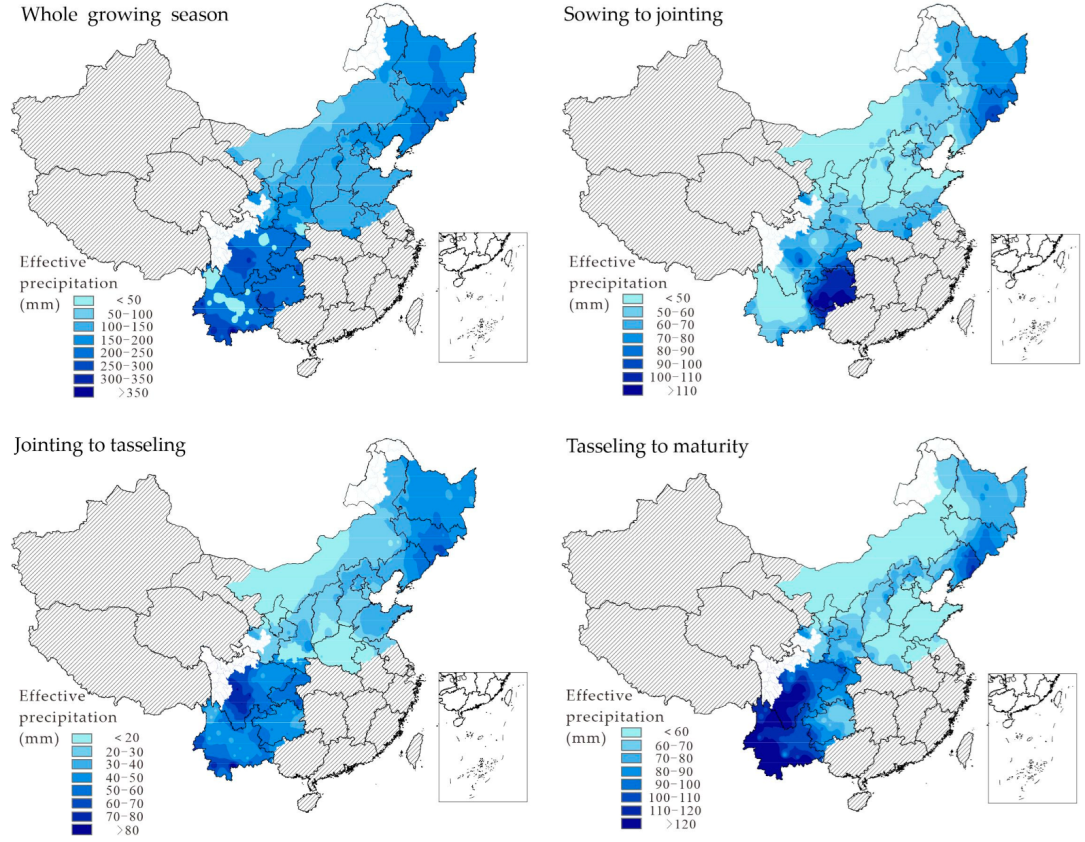
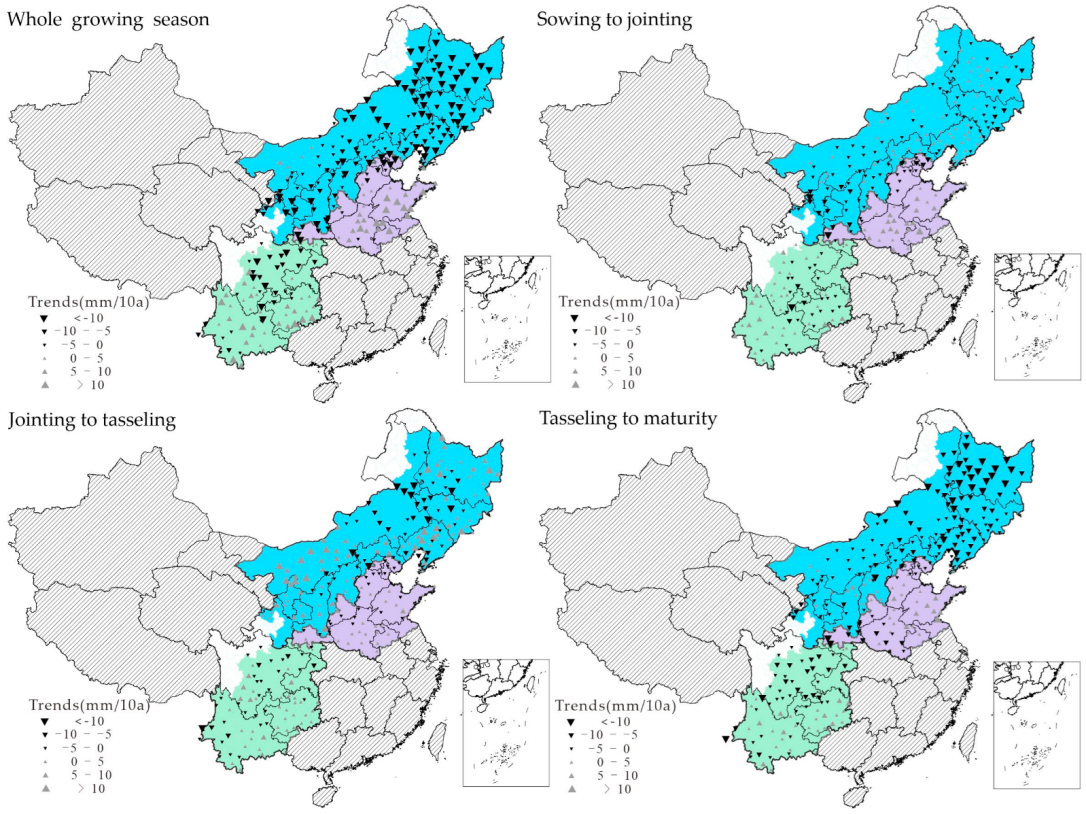

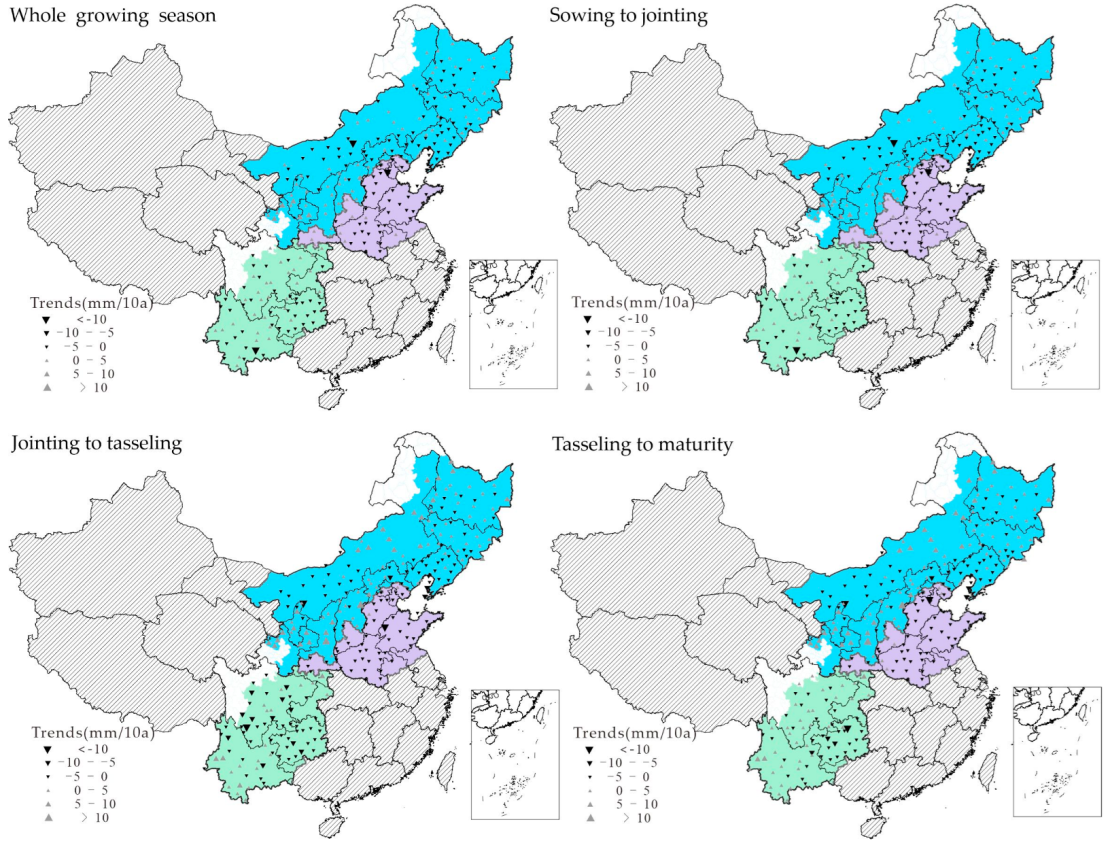
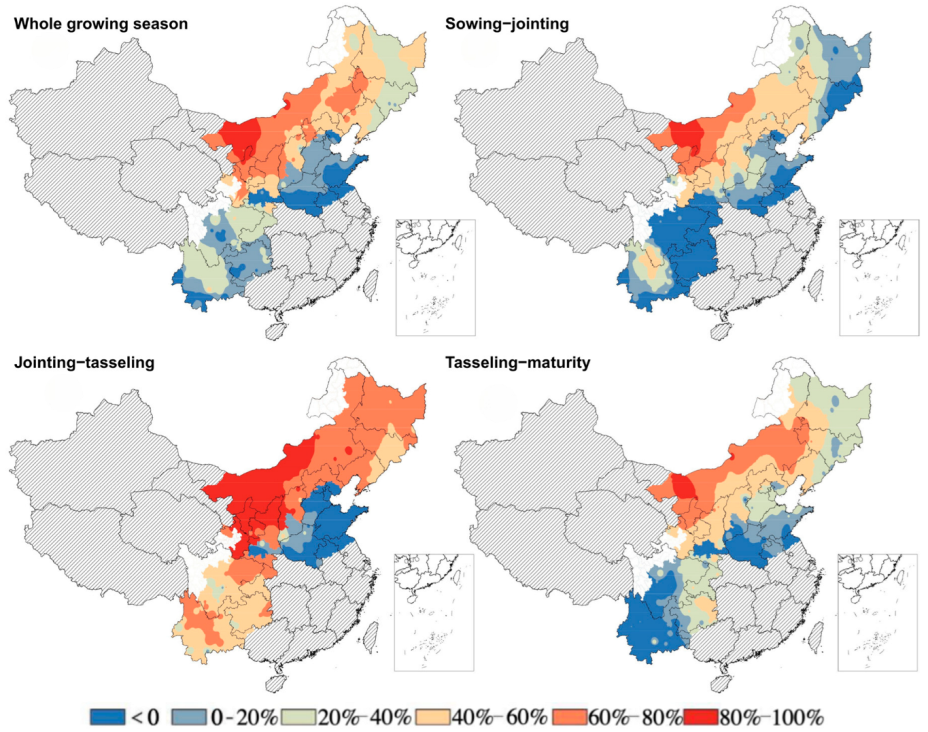
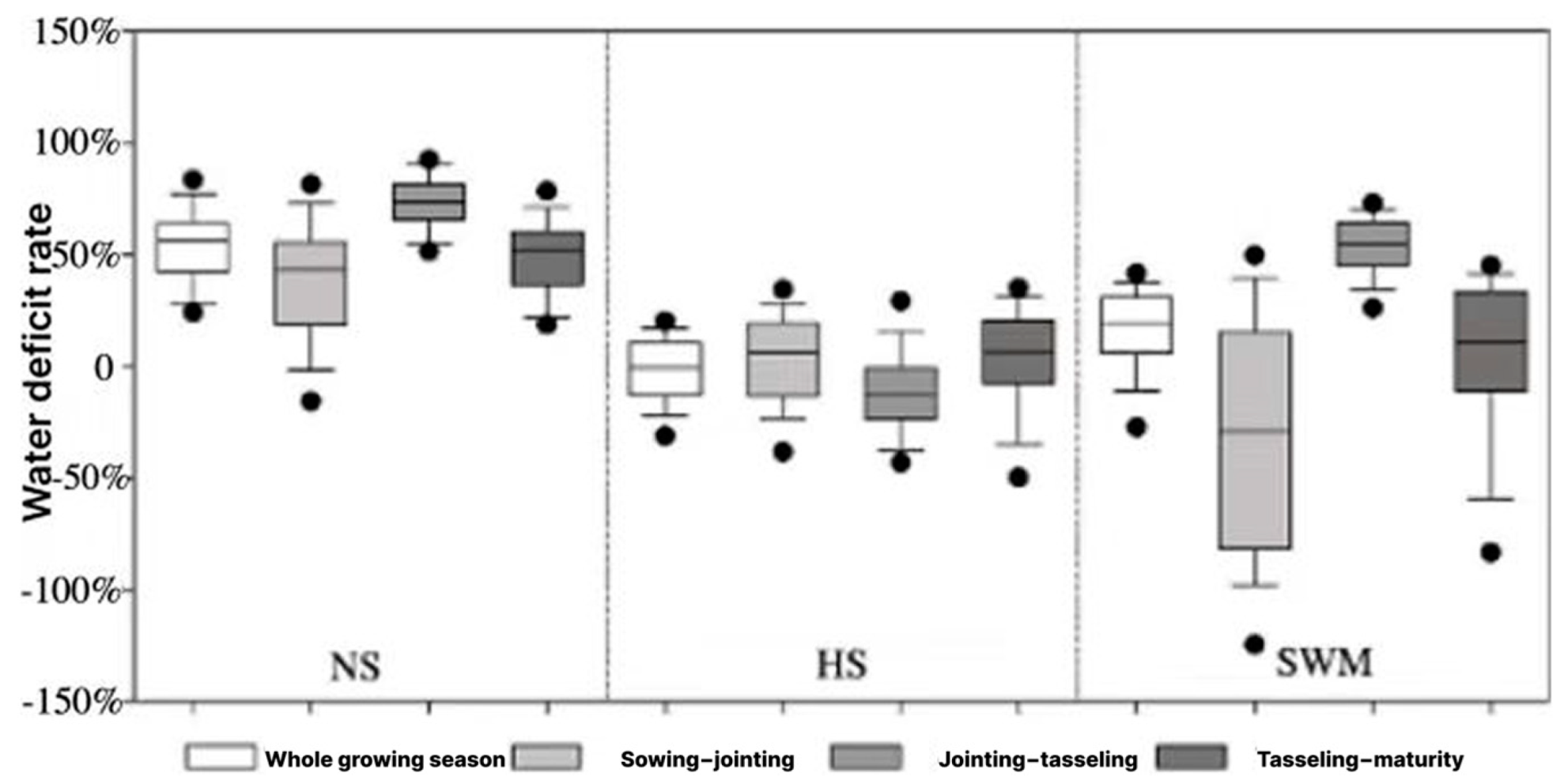
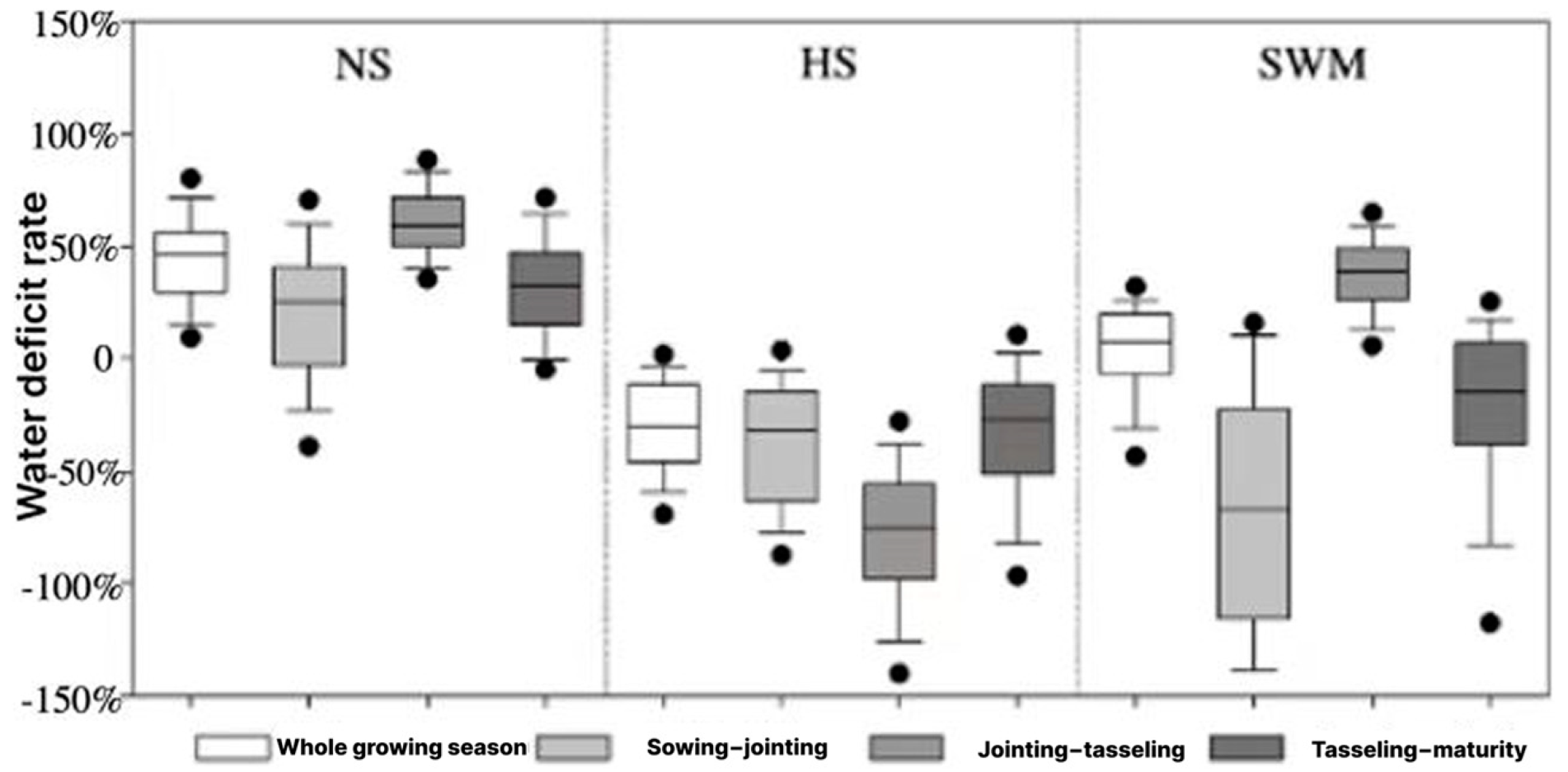
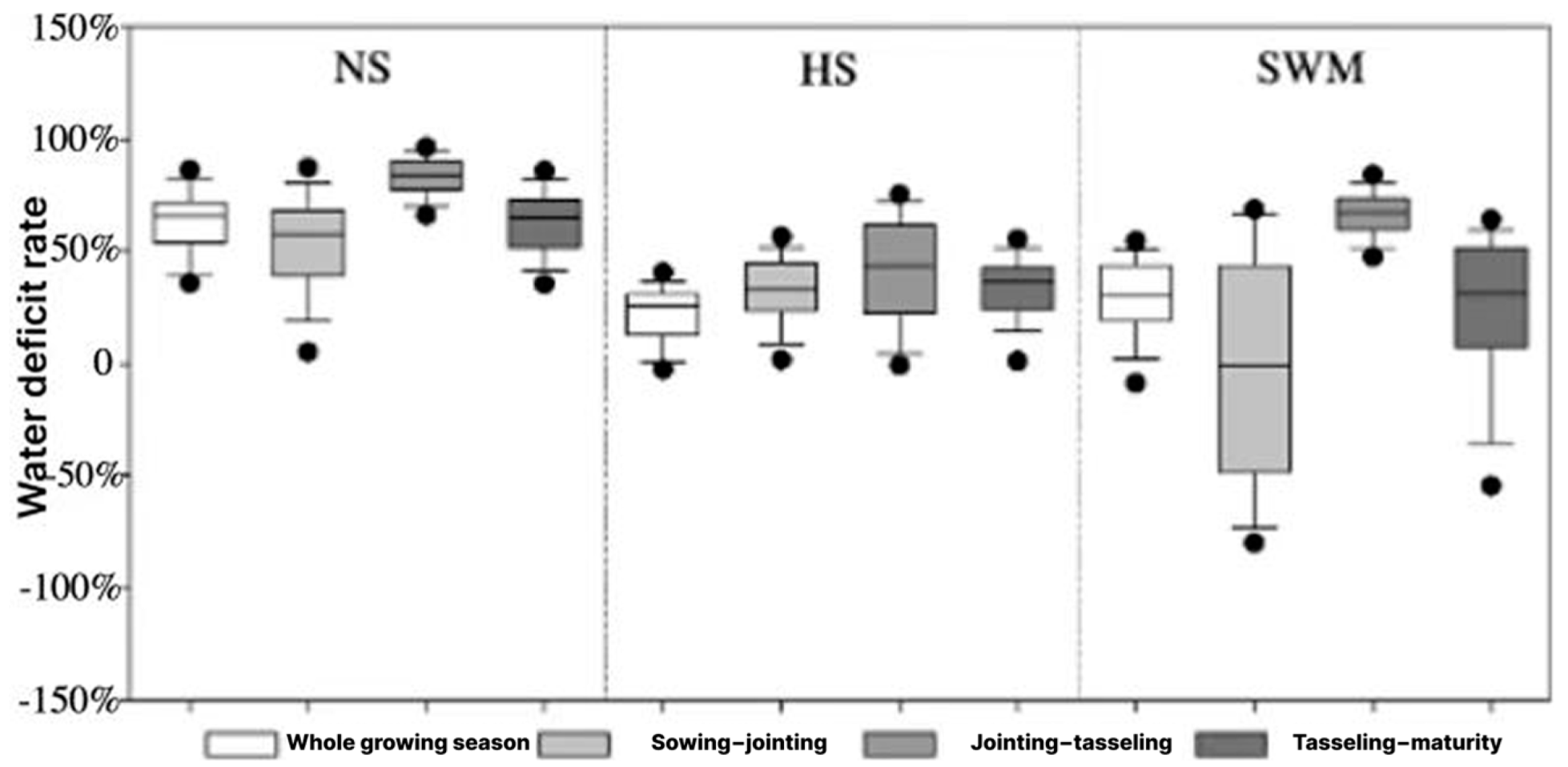
Disclaimer/Publisher’s Note: The statements, opinions and data contained in all publications are solely those of the individual author(s) and contributor(s) and not of MDPI and/or the editor(s). MDPI and/or the editor(s) disclaim responsibility for any injury to people or property resulting from any ideas, methods, instructions or products referred to in the content. |
© 2025 by the authors. Licensee MDPI, Basel, Switzerland. This article is an open access article distributed under the terms and conditions of the Creative Commons Attribution (CC BY) license (https://creativecommons.org/licenses/by/4.0/).
Share and Cite
Wang, Y.; Zhao, J. Temporal–Spatial Patterns of the Water Deficit in the Main Maize-Cropping Regions of China. Agronomy 2025, 15, 728. https://doi.org/10.3390/agronomy15030728
Wang Y, Zhao J. Temporal–Spatial Patterns of the Water Deficit in the Main Maize-Cropping Regions of China. Agronomy. 2025; 15(3):728. https://doi.org/10.3390/agronomy15030728
Chicago/Turabian StyleWang, Yuhan, and Jin Zhao. 2025. "Temporal–Spatial Patterns of the Water Deficit in the Main Maize-Cropping Regions of China" Agronomy 15, no. 3: 728. https://doi.org/10.3390/agronomy15030728
APA StyleWang, Y., & Zhao, J. (2025). Temporal–Spatial Patterns of the Water Deficit in the Main Maize-Cropping Regions of China. Agronomy, 15(3), 728. https://doi.org/10.3390/agronomy15030728






